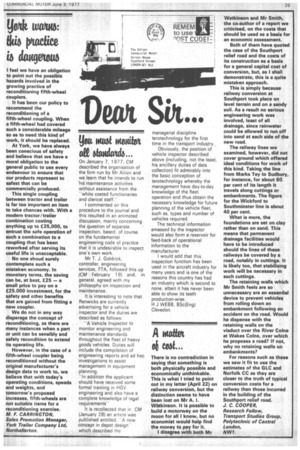A matfett 4 cat...
Page 41

If you've noticed an error in this article please click here to report it so we can fix it.
There is no contradiction in saying that something is both physically possible and economically unthinkable. This is what I tried to point out in my letter (April 22) on railway conversion, but the distinction seems to have been lost on Mr A. I. Wbtkinson. It is possible to build a motorway on the moon for all I know, but no economist would help find the money to pay for it.
I disagree with both Mr Watkinson and Mr Smith, the co-author of a report we criticised, on the costs that should be used as a basis for an economic assessment.
Both of them have quoted the case of the Southport relief road and the costs of its construction as a basis for a general capital cost of conversion, but, as I shall demonstrate, this is a quite mistaken approach.
This is simply because railway conversion at Southport took place on level terrain and on a sandy soil. As a result no serious engineering work was involved, least of all drainage, since rainwater could be allowed to run off into sand at each side of the new road.
The railway lines we examined, however, did not cover ground which offered ideal conditions for work of this kind. Taking the line from Marks Tey to Sudbury, for instance, for about 60 per cent of its length it travels along cuttings or embankments. The figure for the Wickford to Southminster line is about 40 per cent.
What is more, the foundations are set on clay rather than on sand. This means that permanent drainage facilities would have to be introduced should the lines of these railways be covered by a road, notably in cuttings. It is likely too, that stabilising work will be necessary in such cuttings.
The retaining walls which Mr Smith feels are so unnecessary are an essential device to prevent vehicles from rolling down an embankment following an accident on the road. Would he dispense with the retaining walls on the viaduct over the River Caine at Wakes Colne, over which he proposes a road? If not, why no retaining walls on embankments?
For reasons such as these we saw it fit to use the estimates of the G LC and Norfolk CC as they are closer to the truth of typical conversion costs for a railway than those incurred in the building of the Southport relief road. J. C. COOPER, Research Fellow, Transport Studies Group, Polytechnic of Central London, IVW1.




















































































































